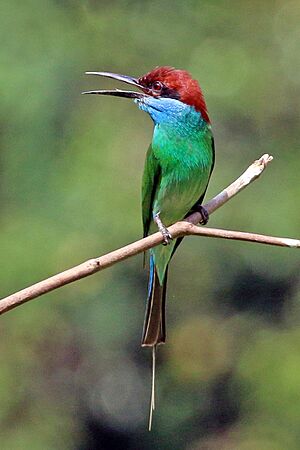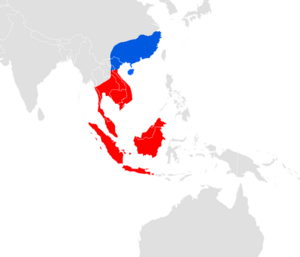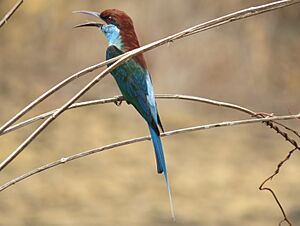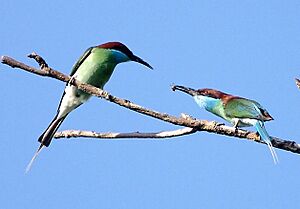Blue-throated bee-eater facts for kids
Quick facts for kids Blue-throated bee-eater |
|
|---|---|
 |
|
| Danum Valley, Borneo, Malaysia | |
| Conservation status | |
| Scientific classification | |
 |
|
| Year round distribution in red and breeding location in blue of blue-throated bee-eaters in Southeast Asia | |
| Synonyms | |
|
Chestnut-headed bee-eater |
The blue-throated bee-eater (Merops viridis) is a colorful bird from the bee-eater family. These birds live across southeast Asia in warm, wet mangrove forests. They mostly eat bees, wasps, and dragonflies.
Blue-throated bee-eaters are small birds. They have bright colors like a red neck, dark green wings, and a light green chest. Their special feature is their blue throat. Young birds are mostly green. They get their full bright colors when they grow up. These birds have many different songs and calls. Some calls help them talk over long distances in the forest.
Blue-throated bee-eaters lay eggs that hatch at different times. This means some chicks are older and bigger than their siblings. Older chicks can get more food from their parents. Sometimes, older chicks are stronger and get most of the food. Blue-throated bee-eaters also travel between islands or to the mainland in Asia. For example, some fly from Sumatra to Malaysia in the spring. They also fly to western China for breeding season.
Scientists say the blue-throated bee-eater is "least concern" for now. This means there are many of them, and their numbers are stable. But cutting down forests is a big danger. It destroys their homes and hurts other bird species too.
Contents
About the Blue-throated Bee-eater
What's in a Name?
The blue-throated bee-eater got its scientific name, Merops viridis, in 1758. A Swedish scientist named Carl Linnaeus gave it this name. The word viridis means "green" in Latin. This bird is the only type in its group. It was once thought to be the same as the rufous-crowned bee-eater. Another common name for it is the chestnut-headed bee-eater.
What Do They Look Like?
Adult blue-throated bee-eaters are about 21 cm long. Their long tail feathers add another 9 cm. They weigh about 34 to 41 grams. Adult birds have amazing colors. They have a red head, dark green wings, and a blue tail. Their chest is light green, and their belly is white. Of course, they have their famous blue throat!
Young birds are mostly green. They have a dark green head and wings, and a light green chest. Both young and adult birds have black patches around their eyes. Their eyes can be red, brown, or a mix of both colors.
What Sounds Do They Make?
Blue-throated bee-eaters make many different sounds. These include loud "longcalls," alarm calls, chirps, and purrs. Longcalls are very loud and strong. They use them to talk over long distances. When they make a longcall, they stretch their beak up high. Chirps are short and sharp. They often use them when digging.
Where Do They Live?
Blue-throated bee-eaters live in many places. You can find them from southeastern China down to the Greater Sundas Islands. They are most common in Singapore, Malaysia, southern Cambodia, and southern Thailand. They also live in Borneo and Java.
These birds like flat areas. This includes farms, gardens, riverbanks, and sandy spots. In winter, some move to forest tops and saltwater channels in mangrove forests. They dig their nests into flat ground. This makes it easier to get in and out than nests on sand cliffs. They can live in groups of 50 to 200 pairs. Some also live alone in open areas.
How Do They Live?
Raising Their Young
Blue-throated bee-eaters have chicks about every 6.2 years. When parents lay eggs, the chicks hatch at different times. This means some chicks are born earlier and are bigger. The eggs hatch over about ten days. The first chick born is usually the biggest.
Parents lay two to seven eggs. But only zero to three chicks usually grow up. The younger, smaller chicks often do not survive. This can happen because older chicks are stronger. They can get more food from their parents. This is more common when there isn't much food. The parents bring insects one by one. This makes it easy for the stronger chicks to get the food. Even if more eggs are laid, it doesn't mean more chicks will survive. Smaller chicks often have more marks or injuries. This makes it harder for them to survive.
What Do They Eat?
These birds mainly eat flying insects. Their favorites are bees and wasps. They also catch flies, beetles, and other bugs up to 42mm long. A lot of their diet is dragonflies. They are best at catching food when it's sunny. They don't hunt when it's raining or right after rain. Their feeding times match the weather. They eat the most during breeding season. This is the sunniest time, right after the rainy season.
Their Journeys
Every spring, blue-throated bee-eaters fly from Sumatra. They cross the Strait of Malacca to the west coast of Malaysia. They flap their wings and glide. Sometimes, they use air currents from the sea breeze to fly higher. Once they reach land, they rest on lighthouses or trees. Then they continue their journey.
From 2000 to 2001, many bee-eaters were seen migrating. Strong warm air currents over Sumatra helped them fly easily over the sea. Many birds were also seen migrating when strong winds blew towards Malaysia. Blue-throated bee-eaters also fly to western China to breed. You can see this on their range map.
Blue-throated Bee-eaters and People
Humans can be a threat to the homes of blue-throated bee-eaters. Their conservation status is "least concern." This means their numbers are stable and they live in many places. This was last checked in 2016. However, cutting down rainforests in Malaysia hurts them. It destroys their homes and reduces the number of different birds in the area.
After forests are cut down, it can take about thirty years for bird numbers to recover. But after this time, the number of different bird species can actually be higher than in recently cut forests.
Sometimes, though not often, these birds are kept as pets. They are also sometimes used in gardening.




